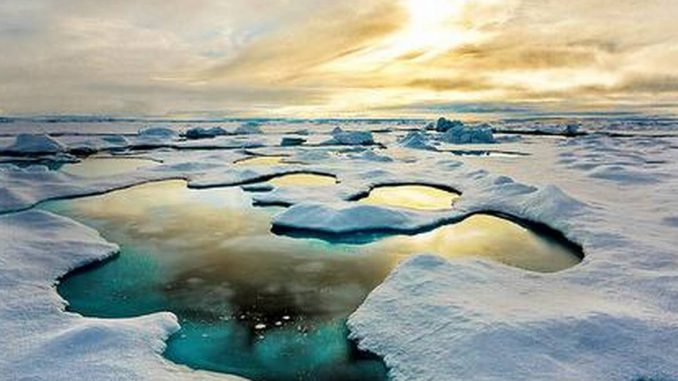
In News
Researchers from NASA’s Jet Propulsion Laboratory and others have identified how arctic ice melt is disrupting and important seawater current called the Beaufort Gyre.
In-Detail
- The Beaufort gyre plays an important role in keeping Western Europe warm.
- But, with the melting of Arctic ice, unprecedented cold freshwater may alter the climate of Europe.
- The gyre contains fresh cold water and flows in a clockwise direction at the surface of the Western Arctic Ocean near Canada.
- It naturally collects the fresh cold water from the melting of glaciers and river runoff.
- According to researchers, this fresh cold water is important as it floats above the saltwater in the ocean and does not allow the sea ice to melt.
- The gyre, as it collects the cold water, it releases the water into the Atlantic Ocean slowly over many decades.
- The Atlantic Ocean current carries the water in small amounts.
- Since the calculations began in 1990, the gyre has accumulated more cold water to the tune of 8,000 cubic kilometres.
- The gain in water, as per the new study is due to the melting of sea ice in summer and autumn.
- The decline in Arctic ice over the decades has exposed the Beaufort Gyre to winds, which spun the gyre faster and allowing it to collect more freshwater.
- Also, the westerly winds moved the gyre in one direction for 20 years.
- This increased the speed and size of the gyre and also keeping the water within the Arctic Ocean.
- In general, the winds reverse their direction every six to seven years, but this movement of wind in one direction for decades is unusual.
- Scientists are of the opinion that if the winds change their direction anytime, the gyre rotates in a counter-clockwise direction, and releases all the stored water at once.
- When such huge amounts of water released into the Atlantic Ocean there would be hemisphere-wide implications for the climate.
- Scientists are of the opinion that the impact will be severe for Western Europe.
- The freshwater, when released into the Atlantic Ocean will alter the Northern Atlantic’s surface water density.
- The Arctic water loses heat and sinks to the bottom of the ocean where it drives the water from the North-Atlantic Ocean to the tropics in a conveyor-belt-like current called the Atlantic Meridional Overturning Circulation.
- This current regulates the heat transfer from tropics to the other parts of the world especially northern latitudes of Europe and North America.
- As per scientists, if the current is slowed down, it could impact all forms of life, especially marine life.
- Though the wind had provided added energy to the Beaufort Gyre, the system is in the balance as the created small circular eddies.
- But, this also poses a risk as it will lead to more sea ice melt with cold freshwater on the surface mixing with warm saltwater from below.
- It also impacts the flow of nutrients and may affect marine life.
Conclusion
The human world is only now discovering the impacts of sea ice melt on climate systems and this research is showing that.

Leave a Reply
You must be logged in to post a comment.